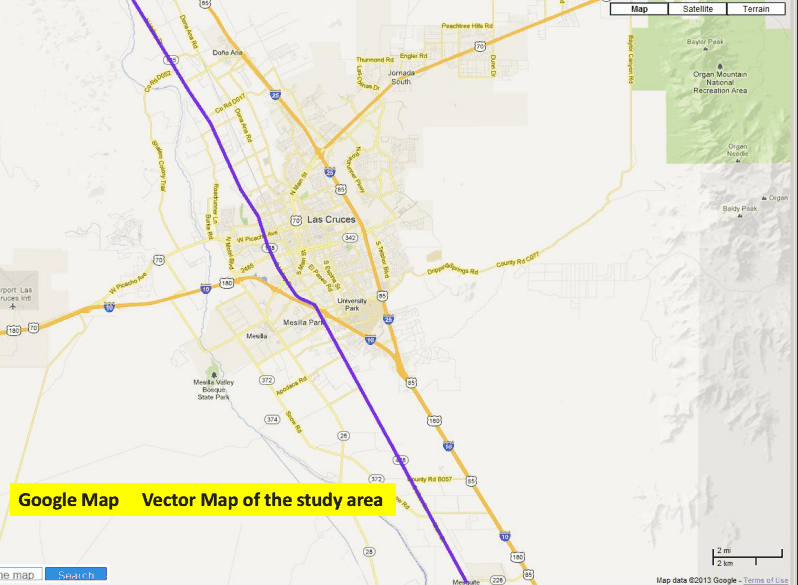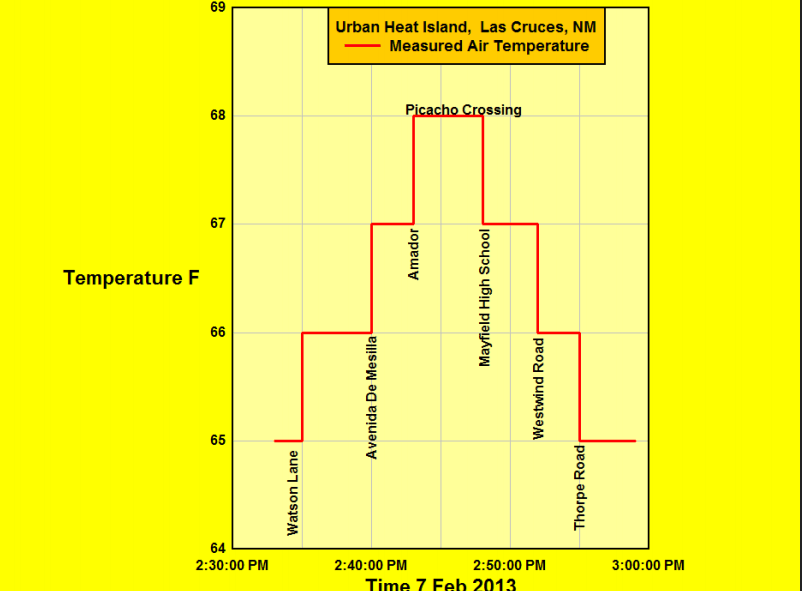Bob Endlich sent over these graphs showing some temperature cross sections he took through Las Cruces, New Mexico. They show very clearly 3-4 degrees of urban warming in the center of the city.
Disrupting the Borg is expensive and time consuming!
Google Search
-
Recent Posts
- Fact Checking NASA
- Fact Checking Grok
- Fact Checking The New York Times
- New Visitech Features
- Ice-Free Arctic By 2014
- Debt-Free US Treasury Forecast
- Analyzing Big City Crime (Part 2)
- Analyzing Big City Crime
- UK Migration Caused By Global Warming
- Climate Attribution In Greece
- “Brown: ’50 days to save world'”
- The Catastrophic Influence of Bovine Methane Emissions on Extraterrestrial Climate Patterns
- Posting On X
- Seventeen Years Of Fun
- The Importance Of Good Tools
- Temperature Shifts At Blue Hill, MA
- CO2²
- Time Of Observation Bias
- Climate Scamming For Profit
- Climate Scamming For Profit
- Back To The Future
- “records going back to 1961”
- Analyzing Rainfall At Asheville
- Historical Weather Analysis With Visitech
- “American Summers Are Starting to Feel Like Winter”
Recent Comments
- Bob G on Fact Checking NASA
- Bob G on Fact Checking NASA
- Bob G on Fact Checking NASA
- arn on Fact Checking NASA
- Gordon Vigurs on Fact Checking NASA
- Bob G on Fact Checking NASA
- Bob G on Fact Checking NASA
- arn on Fact Checking NASA
- conrad ziefle on Fact Checking NASA
- conrad ziefle on Fact Checking NASA





Around here, sw BC, it’s common to hear 2C difference between urban and rural temps on the radio weather reports. Unless it’s really windy.
same in Calgary…in the fall, frost warning…Calgary will be +5 though….I live just south of Calgary, and do temps/precip for environment Canada, and I have seen over 10C difference between my station and Calgary.so is local affect, winds, but a lot is UHI.
Even in the Victorian age, city folks used to escape the heat of the city at the height of summer. A couple of miles from my property is an old Chautauqua village, where John Philips Souza’s band used to play as part of the evening entertainment. People would spend weeks there avoiding the city heat during the ‘dog days’. Locals say that air conditioning eventually dried up the summer crowds, and now it is a time capsule of bungalows and meeting halls.
“Chautauqua (/???t??kw?/ sh?-TAW-kw?) describes an adult education movement in the United States, highly popular in the late nineteenth and early twentieth centuries. Named after Chautauqua Lake where the first was held, Chautauqua assemblies expanded and spread throughout rural America until the mid-1920s. A Chautauqua Assembly brought entertainment and culture for the whole community, with speakers, teachers, musicians, entertainers, preachers and specialists of the day. Former US President Theodore Roosevelt was quoted as saying that Chautauqua is “the most American thing in America”.
http://en.wikipedia.org/wiki/Chautauqua
When it is Tobs or station changes or other adjustments they always come up with an algorithm that automatically changes the raw data. Amazing that they never do it across a city like this suggests should be done.
In other words they are too [email protected] lazy to actually do the work. And for this we pay them a 1/2 a million a year.
The difference between 44th Street in Manhattan and Central Park in summer is a good 10º F. It is considerably cooler yet is surrounded by towering buildings which make the streets unbearable.
Way back in the 1970’s, most buildings were solid pre-war towers. The new ones are all windows.
The first thought I had was “Las Cruces is urban?”
I realize that the UHI doesn’t require an actual “urban” area, but I would have expected such a differential to be associated with a larger developed area.
An interesting empirical exercise showing the effects on a even a small developed area on the UHI.
Good point. I live in Las Cruces, and outside of the University there are not that many buildings over three stories high, generally spread out around town. The routes they apparently took are basically through areas with one-story stores and strip malls, and some neighborhoods. However, because of the thinner, drier air we have here, the impact of the sun at midday might be a little more pronounced, making the UHI effect a little greater. It would be interesting to see some data from other cities.
It’s a very simple experiment to do, which is why Tom Karl never did it.
As I’ve said before, I used to regularly experience a 10° drop over a ¼ mile when just West of the 18th Street interchange on I-70 in KCK. The cool air washing down through the park & meeting up with the cooler air over the Kaw would raise goose bumps on a warm, Summer night when you hit it.
As I’ve mentioned here before, I notice a drop in the air temperature in the evening as I drive a few short blocks from the business district into the residential district in the town where I work, population about 4,000.